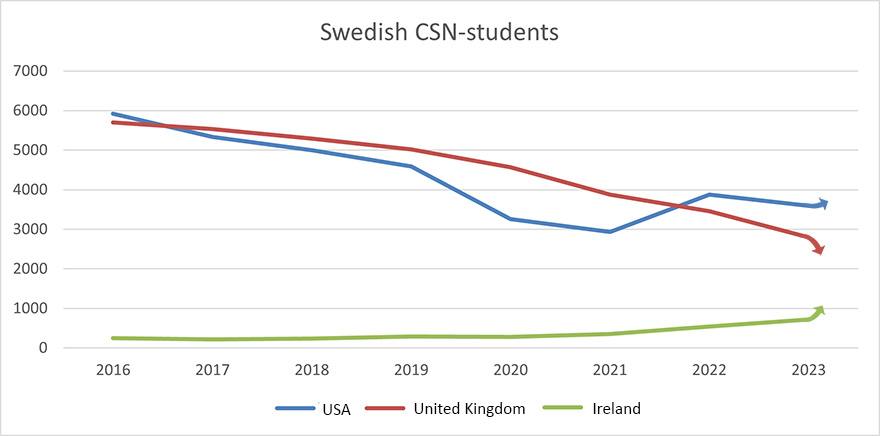How Brexit has affected the Swedish study abroad market
Before Brexit the United Kingdom was the most popular country in the world for Swedish students. Now the numbers are plumeting and the UK is quickly becoming less attractive.
A 50% decline since 2017
A vast majority of all Swedish students who study abroad get grants and loans from the Swedish government body CSN. We have compared the number of Swedish CSN-students studying in the UK before and after Brexit. The picture is clear the number of Swedish students in UK universities are declining rapidly, and it will get worse.
In 2017 the UK was the most popular country in the world for Swedish students. 5538 students received money from CSN for studying in the UK this year. Six out of the 20 most popular schools in the world were from the UK: the University of Edinburgh, the University of Glasgow, the University of Aberdeen, the University College of London, Kings College of London, and London South Bank university all had hundreds of students from Sweden.
In 2023 there were only 2793 Swedish students who still studied in the UK. 50% are gone. The only UK university left on the top 20 list is the University of Edinburgh, but the number of Swedish students there are less than half of what it used to be.
It will get worse
Some might argue that the declining numbers are a cause of the pandemic, but this is not the case. While other markets have recovered the graph for the United Kingdom is still pointing down. In spite of an expensive dollar and political turmoil, the US is now the most popular country for Swedish students with 30% more Swedish students than the UK.
The number of Swedish students in Ireland has increased by 320% since 2017. The reason is that more and more students choose Ireland over the UK after Brexit for reasons we will have a closer look at below.
However, we are convinced that the number of Swedish students in the UK will continue to decline and it will still be a couple of years until we reach the bottom. The reason for this is that the current statistics still include students who started their studies during the transition period who were promised home fees in England and free tuition in Scotland for their entire degree. Once these students have graduated we will see how many Swedish students will keep going to study the UK. This will depend a lot on how the tuition fees develop as we will discuss below.
Tuition fees are the main cause of the decline
The biggest reason for the decline in Swedish students after Brexit is no doubt the big increase in tuition fees. The universities of Glasgow, Edinburgh, and Aberdeen used to be the most popular schools in the UK for Swedish students because the tuition was free, just like in Sweden. Students could get a desired study abroad experience at a high-ranking university without paying more than they would at home.
And if they preferred studying in London, or other locations in England or Wales, the yearly tuition fee of £9250 was just covered by the tuition fee loans they could get from CSN. But with international tuition fees in the range of £15000-60000/year most Swedish students simply cannot afford it, and even for students who can the investment is a hard sell when you can study free of charge at high ranking universities in your home country.
So why are Swedish students so price sensitive you might wonder, isn’t Sweden a rich country? Sweden definitely is not a poor country, but many households have loans rather than big savings. Much of the wealth is embedded in the welfare system that provides free health care, free maternity/paternity leave, long holidays, childcare, and not least free education. No one saves money for college since higher education is free. Parents are usually not actively involved in their childrens higher education, and few young students have enough money saved to pay for tuition fees.
So how can the US be more popular when their tuition fees are even higher? The fact is that the most popular schools for Swedish students in the US are Community Colleges where the tuition fee can be fully covered by CSN. US universities also tend to be more generous with scholarships sometimes even giving students guaranteed scholarships taking the cost down to the CSN threshold of approximately £10000/year.
So if a UK institution wants to attract more Swedish students they should look no further than their tuition fees and scholarships and try to get as close to the CSN threshold as possible.
Other Brexit drawbacks for Swedish students
While the skyrocketing tuition fees was the worst Brexit effect, the negative impact did not stop there. Other negative side effects for Swedish students after Brexit include:
- A raise in the minimum length for CSN from courses of a minimum of 3 weeks (for EU-countries) to a minimum of 13 weeks (for non EU-countries) with the effect that students can no longer get funding for Summer courses or short-term language courses in the UK.
- No CSN for distance courses or foundation courses with few exceptions Swedish students can only get funding for these program when studying at institutions based in an EU-country. This limits the number of Swedish students that can attend UK universities.
- The need for a student visa in the UK. Studying in the UK is no longer any easier than studying in the US or Australia since EU-students now have to apply for a very costly visa (adding to the financial pressure) for courses that are longer than 6 months.
- It is harder to work as a student. A student visa is required, the number of work hours is limited, and students with the European Health Insurance Card who plan to work in the UK can’t refund the £776 NHS insurance which makes working in the UK very costly.
- It is harder to get a license to work in Sweden with a UK Degree. For students interested in regulated professions such as Medicine, Dentistry, Pharmacy, Nursing, or Psychology it is now harder to get a license to work in Sweden. The Swedish authorities judges your foreign license based on the country where you got it, and for students with degrees from non-EU countries the path to licensing in Sweden is longer and more complex than if they had taken the degree within the European Union.
I am convinced that Swedish students will continue to study in the UK, but unless we see a drastic change in tuition fees or CSN-rules I doubt that we will ever see the prepandemic number of Swedish students studying in the UK again. However, other countries like Ireland will most likely see a continued rise in Swedish student numbers when students are looking for new destinations with more reasonable tuition fees.
More information
DreamStudies helps students with free study abroad information. Fill out our information request form to get help if you are a student.
We help international schools with CSN, marketing and recruitment in Sweden, Scandinavia, and the rest of the world. Contact us for partnerships.
Follow @dreamstudiesabroad on Facebook, Instagram, Tiktok, or Youtube to get updated about our new schools and articles.






















